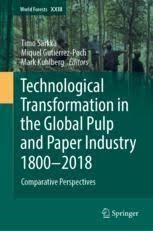Technological Transformation in the Global Pulp and Paper Industry 1800–2018

Introduction
This contributed volume endeavours to analyse the past 200 years of technological
transformation in the global pulp and paper industry from a comparative perspective.
The study is motivated by the realisation that using comparative methods is a highly
revealing way of exposing the complexities the modern pulp and paper technologies
have undergone in the past and of analysing today’s business environment with
changing market dynamics and consumer behaviour.
Methodologically, the study combines transnational, national and regional level analyses with micro level case
studies by focusing on the development of a single industry—pulp and paper. The
research concentrates on the various historical trajectories of the manufacture of
pulp and paper and the technologies related to them. It covers the entire history of
technology transfer in the global pulp and paper industry from raw materials to mill
management, and from transportation to environmental issues. As a result, the book
is arguably the most comprehensive historical analysis of papermaking technology
available.
The investigation is directly linked to The Evolution of Global Paper Industry
1800–2050: A Comparative Analysis (Lamberg et al. 2012), which revealed several
impetuses for an in-depth study of technological transformation in the global pulp
and paper industry. The present volume is primarily intended as a basic introduction to the history of papermaking technology and it is aimed at the same category
of readers as The Evolution of the Global Paper Industry; it is also geared toward
students and teachers as course material at the secondary and tertiary levels and as a
handbook for professionals working either in industry or research centres. The content could be best utilised for raising important questions among the more advanced
graduate audiences by thoroughly familiarising them with the characteristics of the
technological transformation of the global pulp and paper industry. It caters to graduate audiences in four intersected but conventionally separate fields of study, each
having its distinct but interlinked interest and relationship within the pulp and paper
industry: forestry, business, technical sciences, and history.
The primary idea behind the present book was to write a comprehensive volume
that covers all the important areas related to the history of papermaking technology.
Furthermore, it was believed that the need for a volume of this type is very real
and continuing, and that updated research on changes that have been taking place
in some of the key areas during recent years are useful for purposes of teaching
and research. However, it is also obvious that this book pays less attention to certain
topics andregions, which have already been covered in The Evolution of Global Paper
Industry (Lamberg et al. 2012). For this reason, in these cases a complementary use
of both volumes is recommended. The world’s pulp and paper industry is becoming
increasingly global and with a speed unforeseen in the past. Thus covering what is
termed here the global pulp and paper industry runs the risk of becoming outdated
as the geographical orientation of the industry is constantly shifting. For instance,
from the present point of view the emerging pulp and paper industry regions in Latin
America could arguably be considered worthy of investigation. The present study is
not intended to deny their importance. Instead, it outlines the development processes
of the technological transformation of the industry from a historical perspective, and
concentrates on phenomena and regions that are considered to be revealing for the
topic as a whole.
Click here to see full detail of book:



